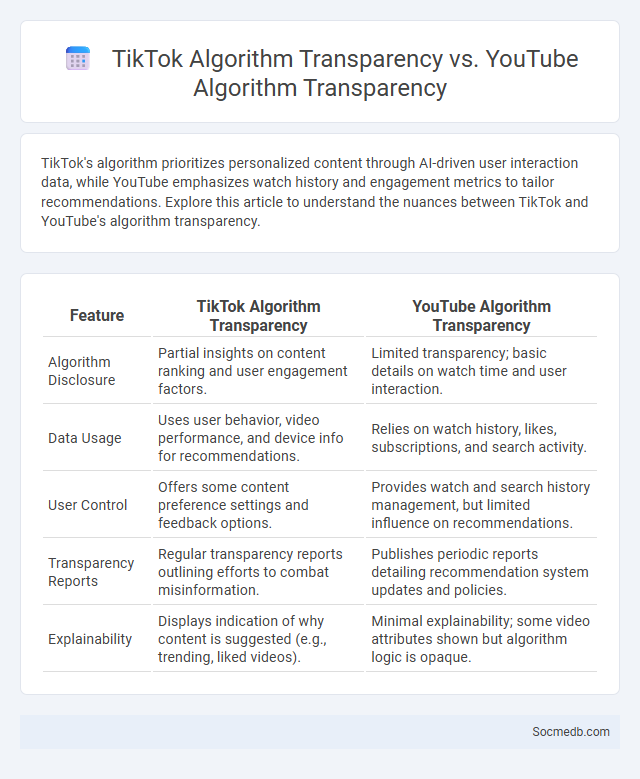
Photo illustration: TikTok Algorithm Transparency vs YouTube Algorithm Transparency
TikTok's algorithm prioritizes personalized content through AI-driven user interaction data, while YouTube emphasizes watch history and engagement metrics to tailor recommendations. Explore this article to understand the nuances between TikTok and YouTube's algorithm transparency.
Table of Comparison
| Feature | TikTok Algorithm Transparency | YouTube Algorithm Transparency |
|---|---|---|
| Algorithm Disclosure | Partial insights on content ranking and user engagement factors. | Limited transparency; basic details on watch time and user interaction. |
| Data Usage | Uses user behavior, video performance, and device info for recommendations. | Relies on watch history, likes, subscriptions, and search activity. |
| User Control | Offers some content preference settings and feedback options. | Provides watch and search history management, but limited influence on recommendations. |
| Transparency Reports | Regular transparency reports outlining efforts to combat misinformation. | Publishes periodic reports detailing recommendation system updates and policies. |
| Explainability | Displays indication of why content is suggested (e.g., trending, liked videos). | Minimal explainability; some video attributes shown but algorithm logic is opaque. |
Introduction to Algorithmic Transparency in Social Media
Algorithmic transparency in social media refers to the openness about how platforms use algorithms to curate and prioritize content. Understanding these algorithms reveals the criteria behind news feeds, content recommendations, and targeted advertising, which impact user experience and information exposure. Enhancing transparency helps users make informed decisions and holds platforms accountable for biases or misinformation.
TikTok Algorithm: How It Works
TikTok's algorithm prioritizes content based on user interactions such as likes, shares, comments, and watch time, ensuring your feed is tailored to personal preferences. It analyzes video information including captions, sounds, and hashtags to match trending or relevant videos to your interests. This dynamic system continuously adapts to your behavior, promoting content that keeps you engaged on the platform longer.
YouTube Algorithm: Mechanics and Functionality
The YouTube algorithm prioritizes user engagement signals such as watch time, click-through rate, and viewer retention to personalize content recommendations. Your interaction history and preferences influence the algorithm's ability to serve relevant videos, boosting visibility for creators who optimize metadata and content quality. Understanding these mechanics allows you to strategically tailor your content, increasing reach and subscriber growth effectively.
TikTok’s Approach to Algorithm Transparency
TikTok emphasizes algorithm transparency by providing users with insights into content recommendations through features like the "Why am I seeing this?" tool, which explains algorithmic decisions based on user interactions and preferences. The platform regularly updates its transparency reports detailing data usage, content moderation, and algorithmic adjustments to enhance user understanding and trust. These efforts align with broader industry trends aiming to balance personalized content delivery with ethical data practices and algorithm accountability.
YouTube’s Efforts Toward Algorithm Transparency
YouTube has increased its efforts toward algorithm transparency by regularly sharing insights into how its recommendation system works and adjusting its algorithms to reduce harmful content. The platform provides creators and users with clear guidelines and tools to understand video promotion and ranking. Your experience on YouTube benefits from these changes as the platform aims to foster a safer and more informative environment.
Comparing Transparency: TikTok vs YouTube
TikTok and YouTube differ significantly in transparency regarding content moderation and algorithmic processes. TikTok provides limited disclosures about how its recommendation algorithms prioritize videos, while YouTube offers more detailed insights through its Creator Academy and transparency reports. Understanding these differences helps You optimize your content strategy based on platform-specific algorithmic behaviors.
Understanding Algorithmic Bias on TikTok
Algorithmic bias on TikTok shapes content visibility by prioritizing videos based on user engagement, often reinforcing existing stereotypes and limiting diverse perspectives. The platform's recommendation system relies on patterns from user interactions, which can amplify popular trends while marginalizing niche or minority content. Understanding TikTok's algorithmic bias is crucial for creating more equitable digital spaces and improving content inclusivity.
Examining Algorithmic Bias on YouTube
Examining algorithmic bias on YouTube reveals patterns where recommendation systems disproportionately amplify content from certain demographics, often marginalizing minority voices. Studies demonstrate that YouTube's algorithms prioritize engagement metrics, inadvertently promoting sensational or polarizing videos that can reinforce stereotypes and misinformation. Addressing these biases requires transparency in algorithmic design and ongoing audits to ensure equitable content distribution across diverse user groups.
Impact of Algorithmic Bias on User Experience
Algorithmic bias in social media platforms often skews content visibility, disproportionately amplifying certain viewpoints while marginalizing others, which can distort user perceptions and reinforce echo chambers. This bias impacts user experience by promoting sensational or emotionally charged content that maximizes engagement but undermines content diversity and accuracy. Addressing algorithmic bias is essential for fostering a more balanced, inclusive, and trustworthy social media environment.
The Future of Algorithm Transparency and Fairness
Social media platforms are increasingly prioritizing algorithm transparency to enhance user trust and accountability in content curation processes. Emerging regulations and advancements in AI ethics emphasize fair algorithms that reduce bias and promote diverse, equitable content exposure. Future frameworks will likely integrate real-time auditing and user control features, empowering individuals to better understand and influence the algorithms shaping their online experience.
 socmedb.com
socmedb.com